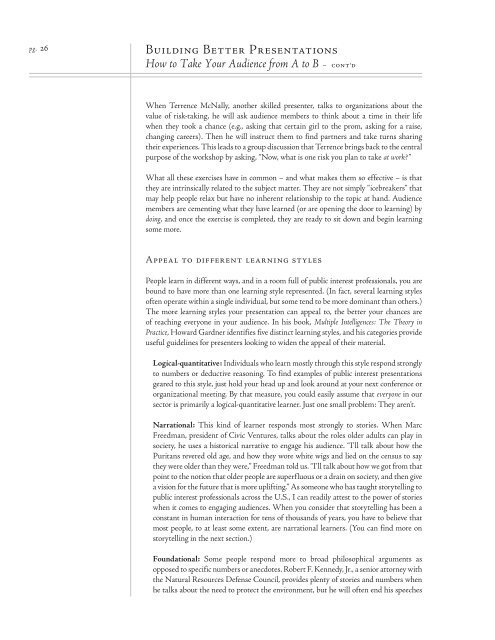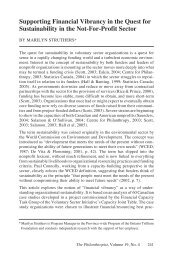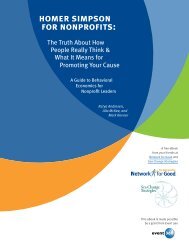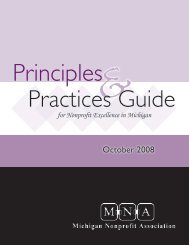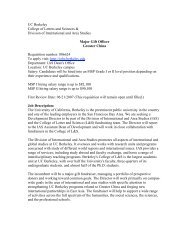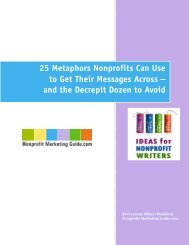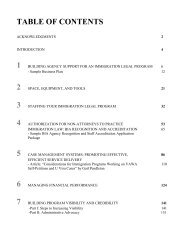Why Bad Presentations Happen to Good Causes - The Goodman ...
Why Bad Presentations Happen to Good Causes - The Goodman ...
Why Bad Presentations Happen to Good Causes - The Goodman ...
You also want an ePaper? Increase the reach of your titles
YUMPU automatically turns print PDFs into web optimized ePapers that Google loves.
pg. 26<br />
Building Better <strong>Presentations</strong><br />
How <strong>to</strong> Take Your Audience from A <strong>to</strong> B – cont’d<br />
When Terrence McNally, another skilled presenter, talks <strong>to</strong> organizations about the<br />
value of risk-taking, he will ask audience members <strong>to</strong> think about a time in their life<br />
when they <strong>to</strong>ok a chance (e.g., asking that certain girl <strong>to</strong> the prom, asking for a raise,<br />
changing careers). <strong>The</strong>n he will instruct them <strong>to</strong> find partners and take turns sharing<br />
their experiences. This leads <strong>to</strong> a group discussion that Terrence brings back <strong>to</strong> the central<br />
purpose of the workshop by asking, “Now, what is one risk you plan <strong>to</strong> take at work?”<br />
What all these exercises have in common – and what makes them so effective – is that<br />
they are intrinsically related <strong>to</strong> the subject matter. <strong>The</strong>y are not simply “icebreakers” that<br />
may help people relax but have no inherent relationship <strong>to</strong> the <strong>to</strong>pic at hand. Audience<br />
members are cementing what they have learned (or are opening the door <strong>to</strong> learning) by<br />
doing, and once the exercise is completed, they are ready <strong>to</strong> sit down and begin learning<br />
some more.<br />
Appeal <strong>to</strong> different learning styles<br />
People learn in different ways, and in a room full of public interest professionals, you are<br />
bound <strong>to</strong> have more than one learning style represented. (In fact, several learning styles<br />
often operate within a single individual, but some tend <strong>to</strong> be more dominant than others.)<br />
<strong>The</strong> more learning styles your presentation can appeal <strong>to</strong>, the better your chances are<br />
of reaching everyone in your audience. In his book, Multiple Intelligences: <strong>The</strong> <strong>The</strong>ory in<br />
Practice, Howard Gardner identifies five distinct learning styles, and his categories provide<br />
useful guidelines for presenters looking <strong>to</strong> widen the appeal of their material.<br />
Logical-quantitative: Individuals who learn mostly through this style respond strongly<br />
<strong>to</strong> numbers or deductive reasoning. To find examples of public interest presentations<br />
geared <strong>to</strong> this style, just hold your head up and look around at your next conference or<br />
organizational meeting. By that measure, you could easily assume that everyone in our<br />
sec<strong>to</strong>r is primarily a logical-quantitative learner. Just one small problem: <strong>The</strong>y aren’t.<br />
Narrational: This kind of learner responds most strongly <strong>to</strong> s<strong>to</strong>ries. When Marc<br />
Freedman, president of Civic Ventures, talks about the roles older adults can play in<br />
society, he uses a his<strong>to</strong>rical narrative <strong>to</strong> engage his audience. “I’ll talk about how the<br />
Puritans revered old age, and how they wore white wigs and lied on the census <strong>to</strong> say<br />
they were older than they were,” Freedman <strong>to</strong>ld us. “I’ll talk about how we got from that<br />
point <strong>to</strong> the notion that older people are superfluous or a drain on society, and then give<br />
a vision for the future that is more uplifting.” As someone who has taught s<strong>to</strong>rytelling <strong>to</strong><br />
public interest professionals across the U.S., I can readily attest <strong>to</strong> the power of s<strong>to</strong>ries<br />
when it comes <strong>to</strong> engaging audiences. When you consider that s<strong>to</strong>rytelling has been a<br />
constant in human interaction for tens of thousands of years, you have <strong>to</strong> believe that<br />
most people, <strong>to</strong> at least some extent, are narrational learners. (You can find more on<br />
s<strong>to</strong>rytelling in the next section.)<br />
Foundational: Some people respond more <strong>to</strong> broad philosophical arguments as<br />
opposed <strong>to</strong> specific numbers or anecdotes. Robert F. Kennedy, Jr., a senior at<strong>to</strong>rney with<br />
the Natural Resources Defense Council, provides plenty of s<strong>to</strong>ries and numbers when<br />
he talks about the need <strong>to</strong> protect the environment, but he will often end his speeches


